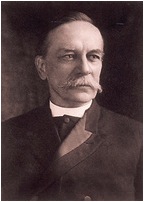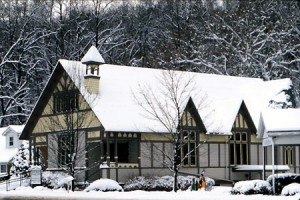The first recorded church service in the Berkeley Springs area was noted in George Washington’s diary on August 20, 1769. He was visiting the springs with his wife, Martha and step-daughter, Patsy Custis at the time. The springs were in the original Norborn Parish and since Washington was an Anglican Churchman, it is thought that the service was Anglican.
His diary entry is brief, but interesting. It reads “Went to Church in the fore and afternoon. Mr. Jno Lewis dined here. Lord Fairfax, ye two Colo. Fairfax’s and other drank Tea here.” This is one of many times we wish that Mr. Washington had been more expansive in his diary entries!
The Rt. Rev. George Peterkin, the first bishop of West Virginia, established an Episcopal mission at Berkeley Springs in 1878. The first service was held in the ballroom of the local hotel. The Rev. W. T. Leavell, of Charles Town, consented to take charge of the mission and services continued in the ballroom, on alternate Sundays with the old established Hedgesville congregation, until a building could be purchased.
He was a diligent man and soon won many friends outside the small Episcopal flock. He drove to town in a conveyance commonly called a “stick-wagon” and remained to help raise money and work towards a new church building. He declined expense money, placing it in the building fund which grew to $900 by 1881. His generosity and zeal inspired local worshippers and attracted the attention of summer visitors at the hotel who admired the work of this saintly man.
The design for St. Mark’s Church was presented by Jay Cooke, who is remembered currently by the cross on the altar.
At the close of the season in September 1881, Bishop Peterkin laid the cornerstone of “St. Marks Protestant Episcopal Church.” A hotel guest, the Rev. Cannon Dixon of Guelph, Canada delivered the sermon. During the next five years, the church was hand built by Henry H. Hunter.
Bishop Peterkin consecrated the building on August 26, 1886 to the service of Almighty God. The sermon on this occasion was delivered by the Rev. Beverly Dandridge Tucker, a Confederate veteran and later Bishop of Virginia, whose family had helped make up the prewar society and one of only a very few southern families who came to post-war Bath.
The well-located lot on which the church building stands, was sold to Moro Phillips of Philadelphia by Elmira Buzzerd for $900. The lot wasn’t deeded to the trustees and Bishop Peterkin until 1890. There seems to be no explanation as to why the property was not deeded to St. Mark’s until after the building had been built.
Only four of the six original members can be determined and these are from the recall of Miss Katherine M. Hunter, a historian whose mother, Mrs. Henry Harrison Hunter was one of the original number and a leader in the church. The others were Miss Mary and Miss Virginia Campbell and a Mrs. Guest. Other charter members were said to also be women.
The dependence of St. Mark’s upon the summer patronage for financial support tied it to the rise and fall of the resort business. Contributions received in the 1888 season supplemented by a mortgage made it possible for the St. Mark’s Rectory to be built. Again, the summer guests helped greatly in this endeavor. Mrs. E. M. Breeze gave $500 and a collection among the people raised enough to retire the last $900 of the mortgage in 1894.
The Rev. Leavell continued to serve the congregation in the summer season until he was succeeded by the Rev. C. C. Pearson on April 1, 1896. Rev. Pearson became St. Mark’s first resident minister.
The reason for the existence of St. Mark’s is to serve the community for the betterment of all God’s people; to respond to the unconditional Love of God.
St. Mark has retained its charm and is a landmark in the Berkeley Springs community.


